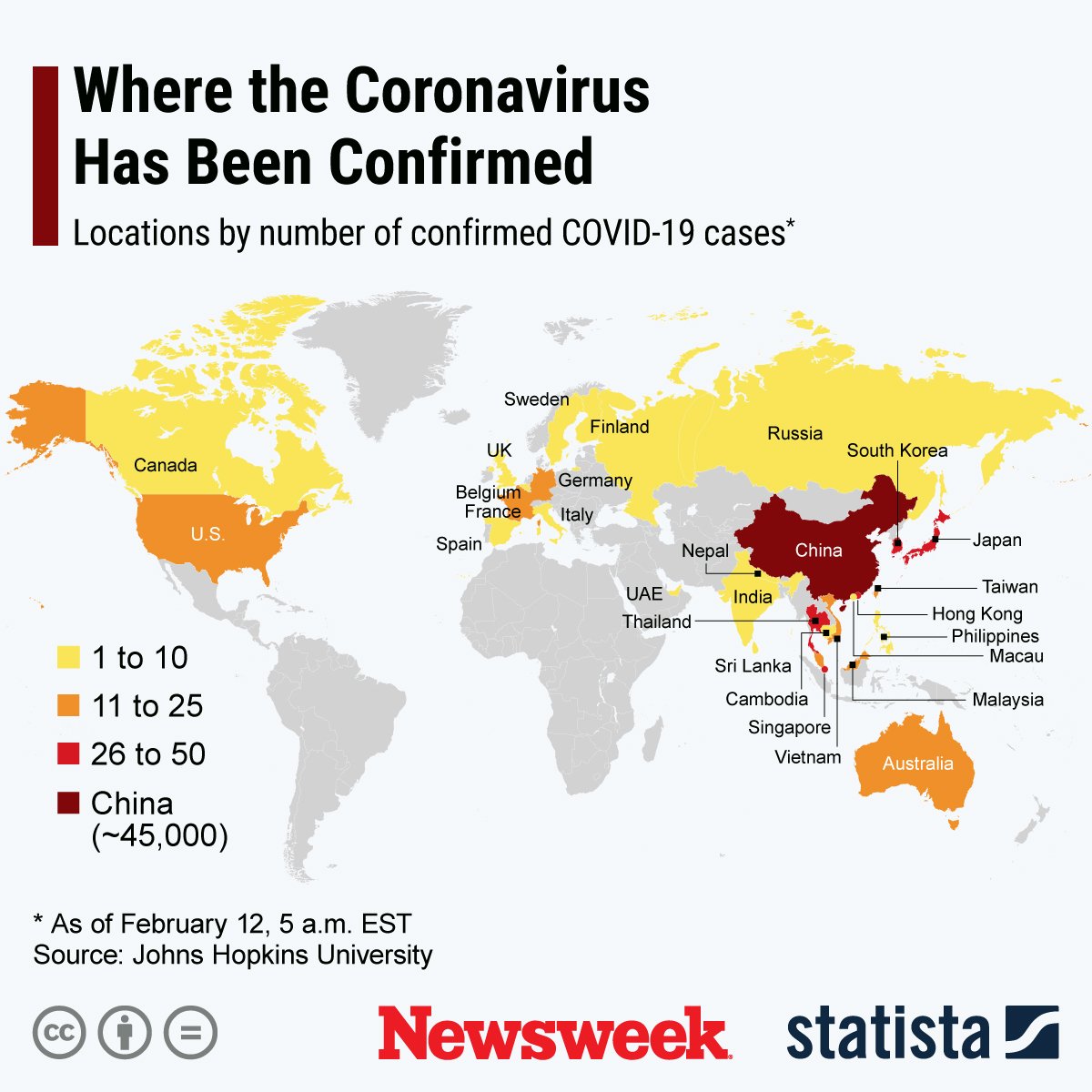Since a new coronavirus started sickening people in the central Chinese city of Wuhan late last year, it has killed over 1,000 people, with all but two in China. As the bug named COVID-19 is new, experts are still learning about its nature—including how it is spread and how contagious it is.
So far, over 44,000 of the more than 45,000 total cases of the germ have been confirmed in mainland China, with Hubei province—where Wuhan is located—bearing the brunt of the fatalities. The bug has reached more than 25 countries and territories, including the U.S., but hasn't been reported on the continents of Africa or South America, as shown in the infographic by Statista below.
At the moment, it is not clear how easily the infection, which can cause pneumonia, passes from person to person. Using the data which is currently available on COVID-19, which isn't a lot, various teams of researchers have arrived at different conclusions for what is known as the bug's reproduction number, R0.
Pronounced R-naught, this is a way of looking at how contagious a disease is by calculating how many new cases an infected person will cause. This is based on a number of factors, including how infectious the pathogen itself is, as well as variables like the strength of a person's immune system. SARS, for instance, had an R0 of between < 1 to 2.75.
One team at Imperial College London in the U.K. believe COVID-19's R0 could be between 1.5 to 3.5, while others at the Chinese Academy of Sciences Institute of Automation have put it at 4.08. Healthcare teams are now working to get COVID-19's R0 to below 1, meaning its spread will decline and it will eventually die out.
As more cases are reported, healthcare workers treat more patients, and scientists study the virus, light is being shed on its characteristics. This process helps experts present, consider, and accept or scrap theories on how it is transmitted.
For example, a study published in the New England Journal of Medicine in January which suggested it could be passed on when a person hasn't yet shown symptoms was shown to be flawed, although experts still believe this type of transmission could be possible, according to Science.
Currently, experts believe it first jumped to humans from animals illegally sold at the Huanan Seafood Wholesale Market in Wuhan as the virus shares features of coronaviruses in bats. It was also previously suggested that snakes could be the source.
However, Paul Hunter, a professor in medicine at the U.K.'s Norwich School of Medicine, University of East Anglia, previously told Newsweek its source "may never be definitively proved." He added: "Ideally we would like to isolate the virus from food animals in the market, but it is likely that the infected batch of animals are long gone."

According to the World Health Organization, which has declared COVID-19 a public health emergency of international concern, the little-understood virus appears to spread between humans similarly to deadly the Middle-East Respiratory Syndrome (MERS) and Severe Acute Respiratory Syndrome (SARS) viruses.
All three are members of the large coronavirus family of pathogens, which also includes milder conditions like the common cold. As such, COVID-19 seems to be passed between humans through droplets when a person coughs or sneezes, surfaces are contaminated by them, as well as through direct contact. It is currently thought symptoms of the virus, including fever, fatigue, and a dry cough, take between two to 14 days to appear.
Other details that experts are now trying to work out include whether it is airborne, if it can pass through water pipes in homes, and to and from pets.
Last month, a Chinese scientist claimed pets can catch COVID-19 and urged owners to be cautious. However, the WHO has said there is no evidence that pets like cats and dogs can get the bug, while stressing it is always a good idea to wash hands with soap and water after contact with pets to prevent the spread of potentially dangerous bacteria.

The U.N. agency has also debunked the myth that the virus can be spread in letters and packages from China, as coronaviruses don't live long on such objects.
Over the weekend, health officials in China appeared uncertain as to whether the deadly new coronavirus can spread through the air. While the deputy head of the Shanghai Civil Affairs Bureau said it might be capable of aerosol transmission, where the virus can linger for some time, others stressed this could happen in theory but there is no concrete evidence to back this claim. Relatively few diseases are spread this way, including measles and tuberculosis.
And earlier this week, over 100 residents were evacuated from an apartment building in Hong Kong after two people living on different floors fell ill with the deadly new coronavirus, prompting fears COVID-19 can be spread through pipes like SARS.
Ivan Hung, chief of the Infectious Diseases Division at Hong Kong University, told CNN that some studies indicate that the virus lurks in fecal matter, but it is not yet known if this could enable it to spread.
Understandably, people are keen to protect themselves from the potentially deadly virus, with some opting to wear face masks. But the U.S. Centers for Disease Control and Prevention (CDC) has said the general public don't need to use them against coronavirus, as it hasn't spread in the general community.
Experts have also highlighted that most people don't know how to use them correctly, and buying up masks can deprive healthcare professionals on the frontline.
To prevent the spread of the disease, the CDC asks the public to follow the usual steps to prevent the spread of respiratory viruses.
These include regularly washing hands with soap and water for at least 20 seconds, particularly after using the bathroom, before eating, and after coughing, sneezing or blowing your nose. When sneezing or coughing, cover your mouth with a tissue or your elbow and throw away the tissue immediately.
Try not to touch your eyes, nose or mouth with unwashed hands. Stay at home if you are sick, and if you are well, avoid those who are ill. Objects and surfaces should be cleaned and disinfected frequently using spray or wipes.
Uncommon Knowledge
Newsweek is committed to challenging conventional wisdom and finding connections in the search for common ground.
Newsweek is committed to challenging conventional wisdom and finding connections in the search for common ground.
About the writer
Kashmira Gander is Deputy Science Editor at Newsweek. Her interests include health, gender, LGBTQIA+ issues, human rights, subcultures, music, and lifestyle. Her ... Read more
To read how Newsweek uses AI as a newsroom tool, Click here.






